The Nagas: Proud indigenous tribes in tryst with modernity
A captivating photography show at the Museo Camera in Gurugram documents the journeys of Pablo Bartholomew and Aditya Arya to the inaccessible world of Nagas at the turn of the century
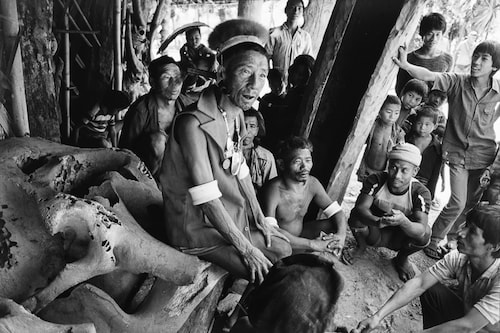

A hand-drawn map displayed at the show marking the territories where Nagas live is an eye-opener: the Nagas can neither be contained nor divided by hastily drawn borders. Living along the Patkai mountain range, which spills over several geographical boundaries in the north-eastern states of Nagaland, Manipur, Assam, Arunachal Pradesh and across Myanmar, the Nagas comprise over thirty indigenous tribes. These tribes, with over sixty spoken dialects, are proud people who continue to hold their own constitution, flag and identity. They bear similar traits yet are so diverse and distinct that every tribe could virtually be a nation unto itself.
According to the oral traditions of many Naga tribes, their ancestors migrated from far North in present-day China, travelling through the jungles of Myanmar to arrive at Makhel, a small village in the Senapati district in Manipur near the border with Nagaland. Before they dispersed from the prosperous village in search of new lands, the people of Makhel planted a pear tree they regarded as sacred and took a solemn oath that they would one day come together again. The tree, called Chà¼tebu, still stands, as does a megalith, erected in memory of the tribe"s dispersal.
Ensconced on hilltops, the Nagas were fiercely independent, self-sustained and autonomous, steeped in animism and the belief that all things stem from and continue to be tied to the past. The tribes were famed for their resistance against incursions into their territory, from the Tai-Ahom invasion in the 13th century to the British colonial incursions in the 19th century. However, the tribes couldn"t resist the Protestant Christian missionaries who were instrumental in introducing Western education and proselytising Naga people to Christianity. Shortly before India"s independence, the Naga National Council was formed to demand the Naga peoples" autonomy and self-determination. The Council declared their independence in August 1947 and again in January 1950, which led to a bitter guerrilla war with Indian forces in the Naga hills and a long-standing insurgency thereafter.
Aditya Arya and Pablo Bartholomew were drawn to the region during the 80s when Nagaland and the surrounding area were still inaccessible and closed to the outside world.
Aditya Arya, who had spent his early years exploring regions around the country, was assigned to photograph Nagaland in 1984 for the Festival Of India, the largest cultural programme of its kind intended to bring India alive to the West, showcasing its major artists, artisans, performers and national art treasures. This assignment marked the beginning of Aditya"s self-funded exploratory work and visual documentation of this remote area, inspired by accounts of early travellers and anthropologists, a project that spanned over six years.
Pablo Bartholomew"s Naga project was inspired by his father recounting the hospitality and kindness of the Naga tribes he encountered while fleeing from persecution by Japanese forces in Burma (present-day Myanmar) to India. This sparked Pablo"s curiosity, leading him in 1989 to embark on a decade-long exploration of the Naga tribes across the North East. Despite the dangers of low-level warfare between the Indian army and secessionist groups, he navigated these remote areas in his customised Maruti Gypsy, which doubled as a portable photo studio loaded with lighting equipment and a generator, documenting the Naga people and their lands, turning it into a visual anthropological project.
Decades later, these images of the warrior tribes, a document of vanishing indigenous traditions, exhort us to respect ways of living diverse from ours.
Excerpts from a conversation:
Q. In this decade, when analogue cameras and film are back in fashion, it"s wonderful to see your bodies of work on Nagas, separated by time, come together in a show.
Aditya Arya: I heard of Pablo"s show on Nagas two years ago at Nine Fish Gallery in Mumbai. It was a trigger for me to revisit my time in Nagaland, which was about seven years before he started exploring the region. I"ve been trying to digitise my various bodies of work for the last two years. While my work was in black and white, Pablo worked in colour. I proposed a show to Pablo, and everything fell into place.
Pablo Bartholomew: Aditya proposed, and I immediately accepted because I had a ready show anyway, so it was a matter of moving it from Mumbai, where it was being stored.
Q. The pictures are a strong reminder of how quickly cultures can and have changed in recent decades.
PB: Yeah, a generation changes a lot. Aditya went in 1984, which is nearly two generations and things change. I mean, there"s the modern world that comes into Naga culture, and then there are changes within the religious Baptist structure, which also changes things. The more there is connectivity, physically through roads, rails, airlines, and the internet, everything you know starts to fall apart. There are also now the revival movements where the Naga people are trying to come together to keep the past. There are people who have their own private collections on the Naga, and small museums are also coming about, so there is an assertion of identity. There"s also talk of wanting to get things back from the British museums, which is termed now as plunder of their heritage. These conversations have started. Bringing stuff back and all is okay, but the question remains. Is there a facility to store and display it?
AA: Photographers have a very important role to play. They are visual documentarians of their time, leaving behind legacies for future generations to interpret of a time that cannot be brought back.
PB: No AI can bring it back.
AA: This has its own value as an important visual anthropological study of the times.
Q. You first went to Nagaland on an assignment for the now legendary Festival of India?
AA: Yes, it was a project inspired by Pupul Jayakar. Some Naga dances had to be photographed, and they took me to Nagaland, which was pristine. I didn"t have time then to explore. I went back immediately, and then the love affair with the tribe started, which lasted almost six years. I went back and forth to various villages, taking breaks from my commercial work because that"s where my money used to come from.
Q. And so it was completely self-assigned...
AA: Absolutely. Self-funded, self-assigned, nobody to tell you what to do. In your case, too, by the way, Pablo?
PB: Through some grants... I was one of the first recipients of the Times fellowship grant on its launch. The environmentalist Nemichand Jain, who was on the board, interviewed me and asked me what my intentions were. When I got the grant, I used the money to buy a Maruti Gypsy to travel in those areas because it"s impossible otherwise. This gave me freedom. So the seed money was well invested in a Gypsy pick-up, which I got converted to a five-door to carry a generator and lighting equipment. So it was an interesting time. I travelled from 1989 till about 2000.
Q. The striking thing about animistic cultures is how their reverence for Nature reflects in their beliefs and practices and extends right down to their dresses and adornments…
AA: What is sad is how, over time, the church and the government made the Nagas rid of all their cultural artefacts and get over their beliefs, saying they were not good for society. Today, many of these ethnic groups tell me they wish they had not thrown away, burned or buried their legacy. Today"s generation has this great celebration called the Hornbill Festival, where they use plastic ornaments and plastic feathers. They say they"d love to touch some of these original things but don"t know where they are!
PB: It was a missionary dictat because the animist religions were considered pagan. What happened was a cultural genocide. So, the thing is, how do you define identity? At the end of the day, all these rituals, rites, and practices, whether you look at them as good or bad...
AA: (Interjecting) Who is deciding what"s good or what"s bad?
PB: …these mark an identity. If you see a Naga dressed in a three-piece suit, at the end of the day, he"s like a copy of what has epitomised for years as a successful Hong Kong Chinese businessman. Is that what your identity is? Obviously not. But the fact is that if you don"t have your textiles, your fabrics, your ornamentation, your tattoos, and your cultural heritage, then you"re reduced to just that.
Q. But one can"t stop progress, no matter what form it may take.
AA: No, one can"t. But you have to cherish the past and celebrate the present. Which is what the museums are meant for—to preserve the past.
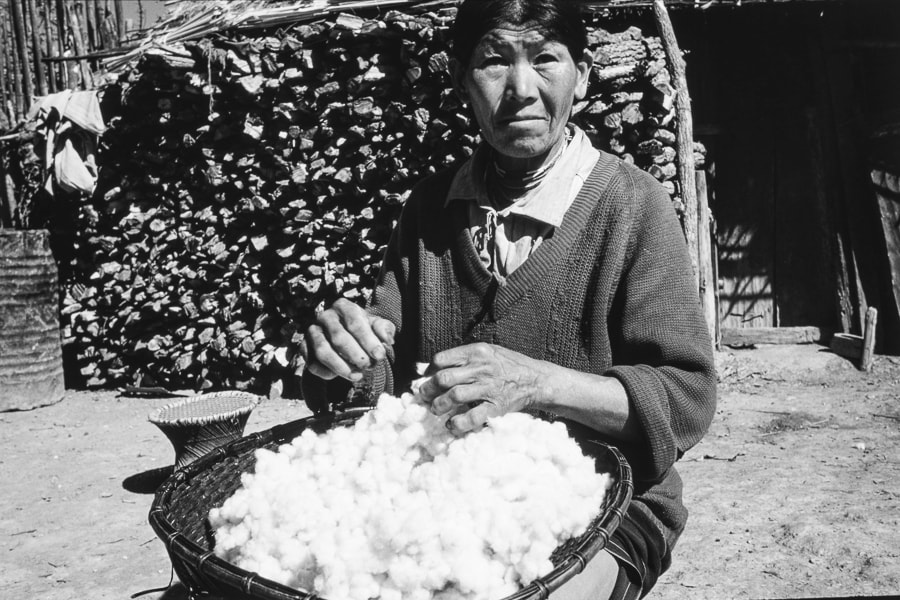 Image: © Aditya Arya
Image: © Aditya Arya
In Nagaland, weaving, spinning, and dyeing yarn are the domain of women. The Naga have long been known for their striking handwoven fabric, whose colours, motifs, and patterns define the identities of individuals and groups.
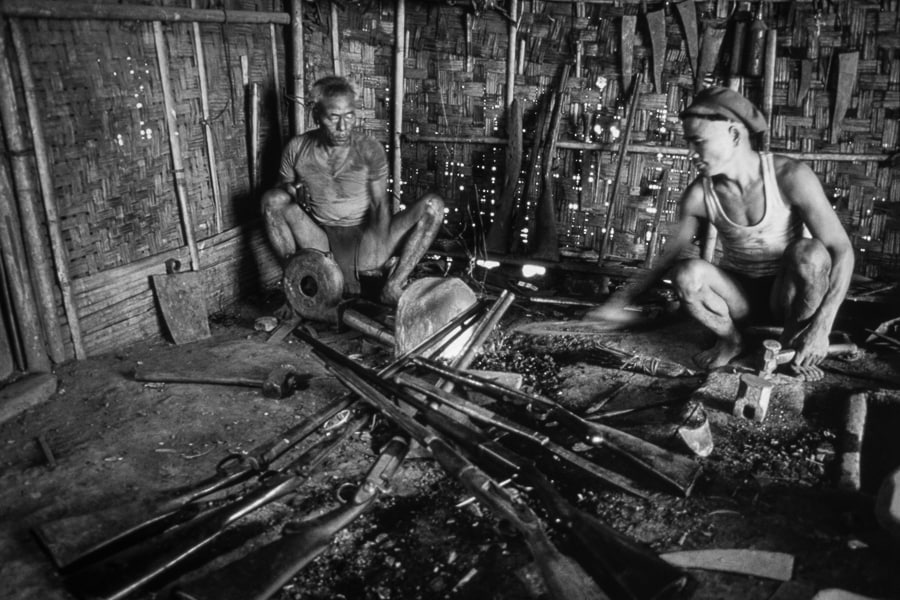 Image: © Aditya Arya
Image: © Aditya Arya
Interior of a Konyak gunsmith"s shop. The Konyak learnt the skill of making muzzle loaders from Myanmar in pre-colonial times. Later, the quelling of a Manipuri rebellion in 1891 resulted in a large number of guns being available in the Naga Hills.
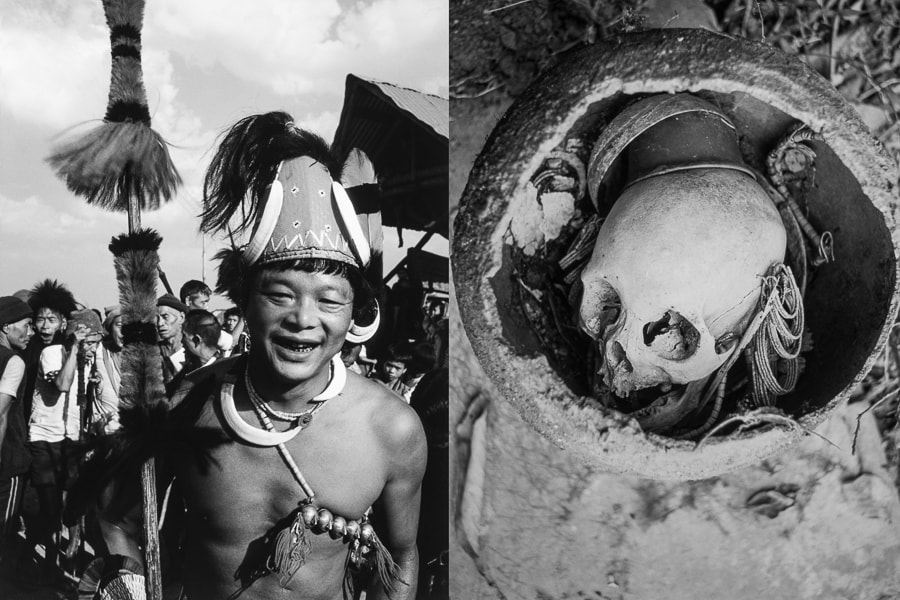 Image: © Aditya Arya
Image: © Aditya Arya
(Left) A Konyak Naga in his resplendent headgear. (Right) The Konyak traditionally practise two death ceremonies for their heroes and Angs. In the first, the deceased is wrapped in a shawl, placed on a bamboo bier and allowed to decompose till it is possible to separate the head from the body. The second ceremony takes place after the head is cleansed by elders of the deceased"s clan and placed in an urn by a woman of the tribe. The urn is then placed at a burial site outside the village and is ritually offered food and zu at all festivals for a year, by which time the soul of the deceased would have left the village.
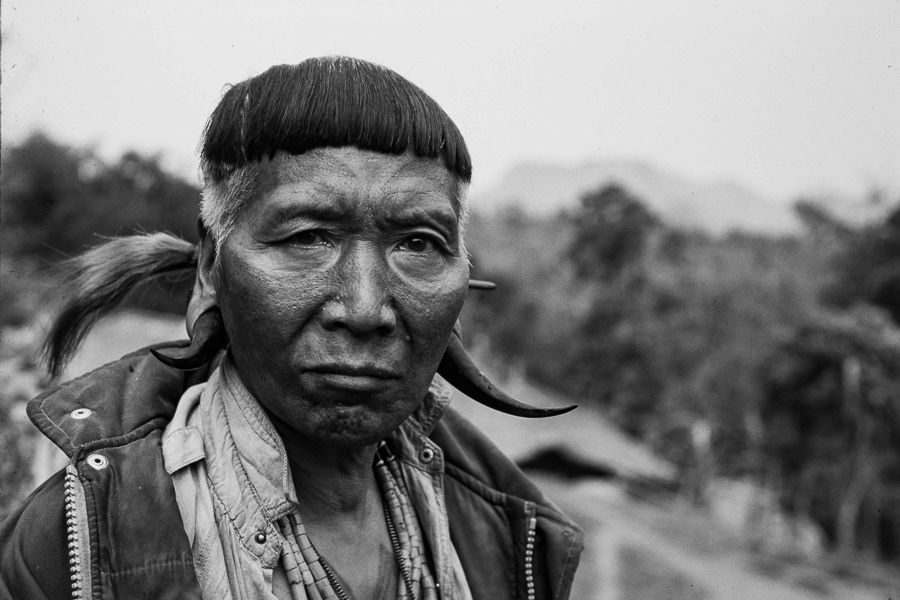 Image: © Aditya Arya
Image: © Aditya Arya
Facial tattoos are marks of a Konyak head-taker, and the various designs indicate the person"s prowess in battle and the number of heads he has taken. The origin of tattooing is obscure. The Konyak are divided into the Thendu (lower Konyak) and the Thenko (upper Konyak ). The Thendu (also known as Thenthu) tattoo their faces and bodies while the Thenko decorate their bodies but not their faces. The Thendu are governed by the Ang (chief), while the Thenko, like the Ao and Angami, are governed by councils of village elders.
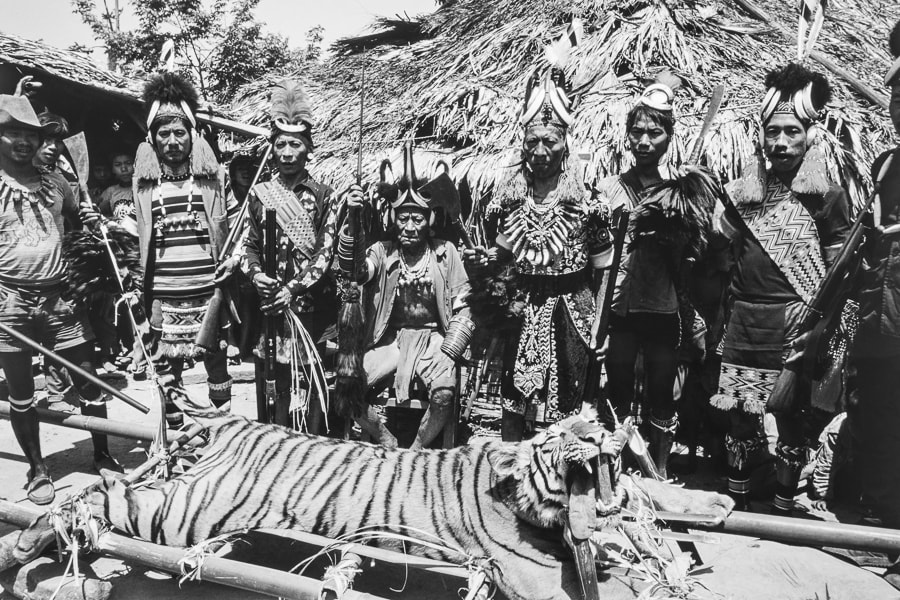 Image: © Aditya Arya
Image: © Aditya Arya
Amongst many Naga, there is a strong link between a man and a tiger. The two were brothers in the distant past but later separated. A strong belief in lycanthropy exists in all tribes. Some men have their "familiars" as tigers and suffer the same pains and injuries that the other suffers. Tigers, therefore, are not hunted for sport but are killed only when the villagers believe a familiar is haunting their village. The killing of a tiger is equivalent to a successful head-taking raid with all the consequent benefits to the well-being of the village and the fertility of its fields.
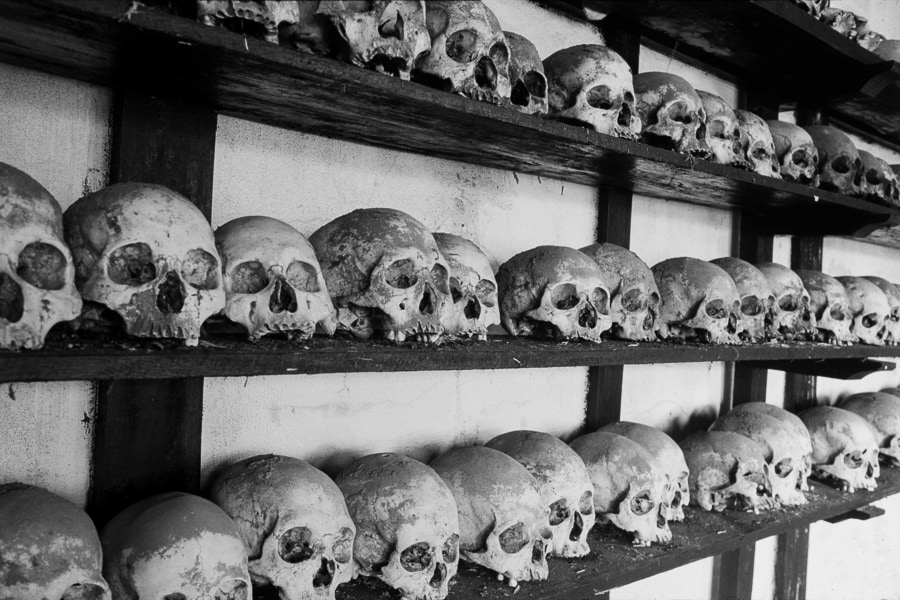 Image: © Aditya Arya
Image: © Aditya Arya
The life force from all these slain enemy heads is believed to have given the Konyak village of Chui its prosperity and renown. The heads are to be viewed in this light rather than as war trophies. A head-taker gains respect and admiration among his peers and villagers. Head-taking ended abruptly in the villages that came under British administration.
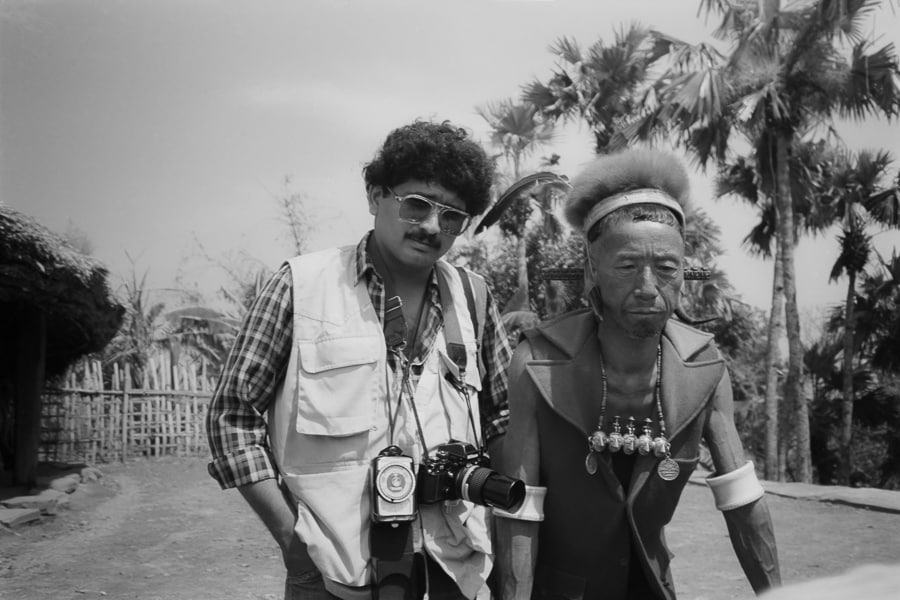 Image: © Aditya Arya
Image: © Aditya Arya
Aditya Arya with the Great Ang (chief) of Chui in 1984
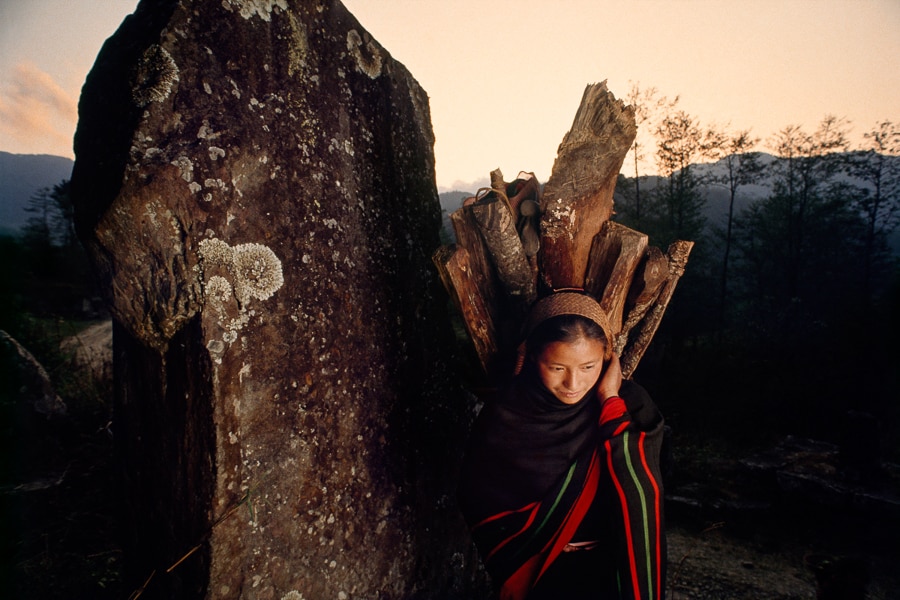 Image: © Pablo Bartholomew
Image: © Pablo Bartholomew
A village woman on her way back from the jungle after collecting wood stands next to a memorial stone, wearing a Lohe: the traditional Angami Naga shawl with three coloured stripes of red, green, red and another red border set off against a black base, Khonoma, Nagaland.
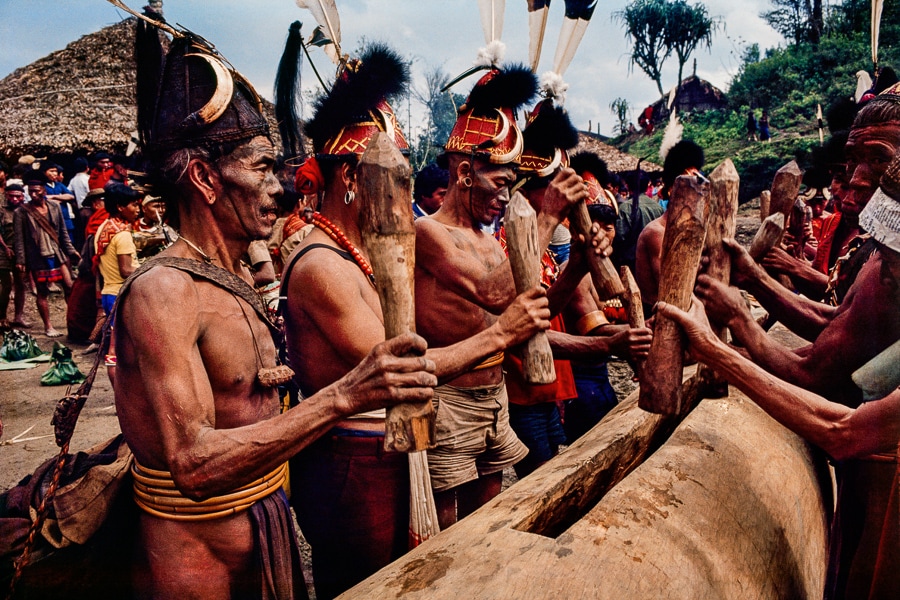 Image: © Pablo Bartholomew
Image: © Pablo Bartholomew
The villagers at Lungwa beat the log drum in a frenzy and dance. Vassal tribes from neighbouring Myanmar (Burma) villages also participate in the festivity. In the Angami, Pomei and Maram Naga tribes, the log drum is used as a large vessel to brew rice beer. Recently, the log drum has been used to warn of army patrols approaching a village. Mon District, Nagaland.
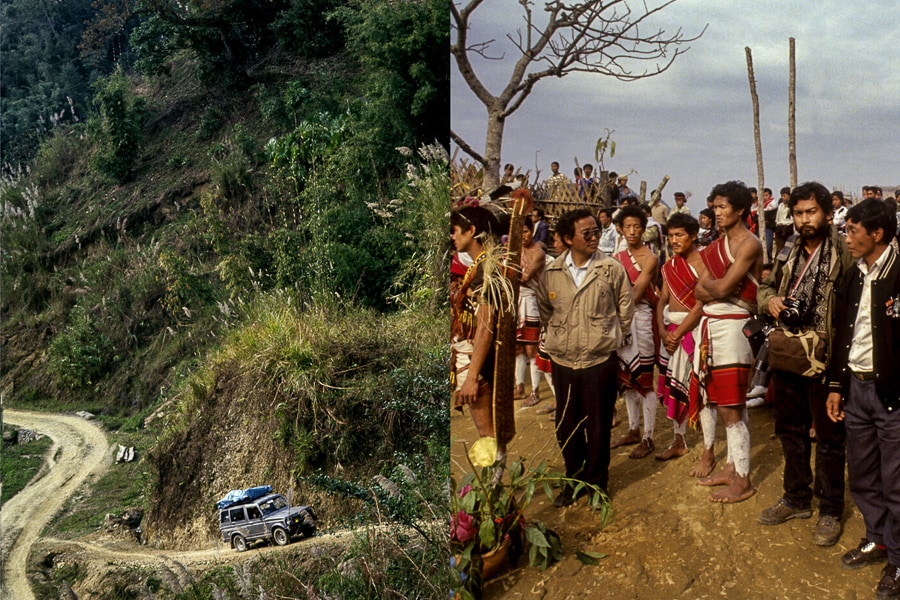 Image: © Pablo Bartholomew
Image: © Pablo Bartholomew
(Left)The Maruti Gypsy that Pablo Bartholomew drove, customised and converted to carry lighting equipment that included strobe units, auto-poles and a generator during his 10-year venture to photograph the Naga people in Arunachal Pradesh, Nagaland and Manipur. (Right) The photographer Pablo Bartholomew (second from right) at a ritual event amongst the Naga tribes of Manipur.
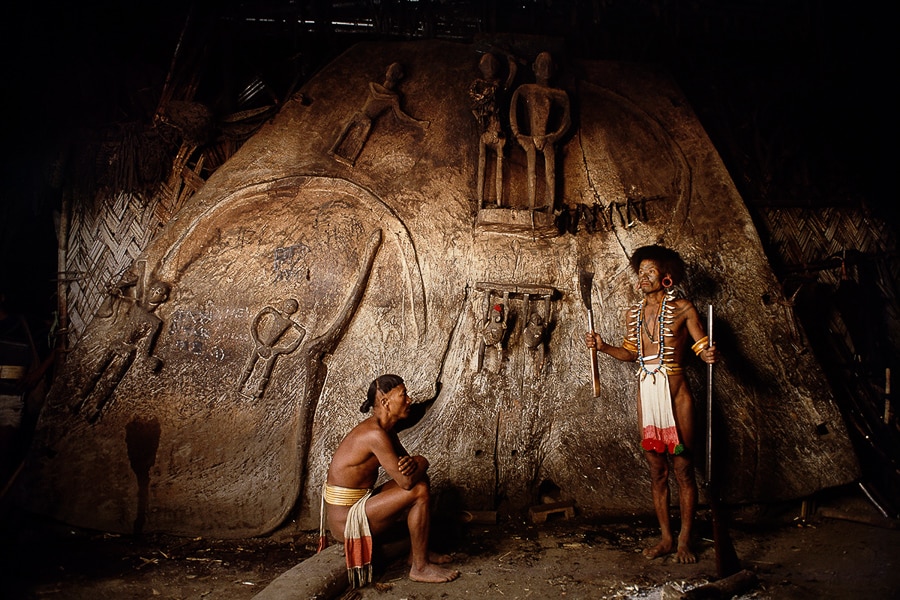 Image: © Pablo Bartholomew
Image: © Pablo Bartholomew
Two Wanchoo warriors stand in front of this large piece of carved wood that contains their myths and legends and shows elements like the snake, rainbow, warriors, monkeys, and a couple standing. The Wanchoos, now in Arunachal Pradesh, believe that they migrated from Shangyu village in Nagaland. The whole tract was known as NEFA (North-Eastern Frontier Alliance) back then, and these state boundaries have only come into existence since the 1960s.
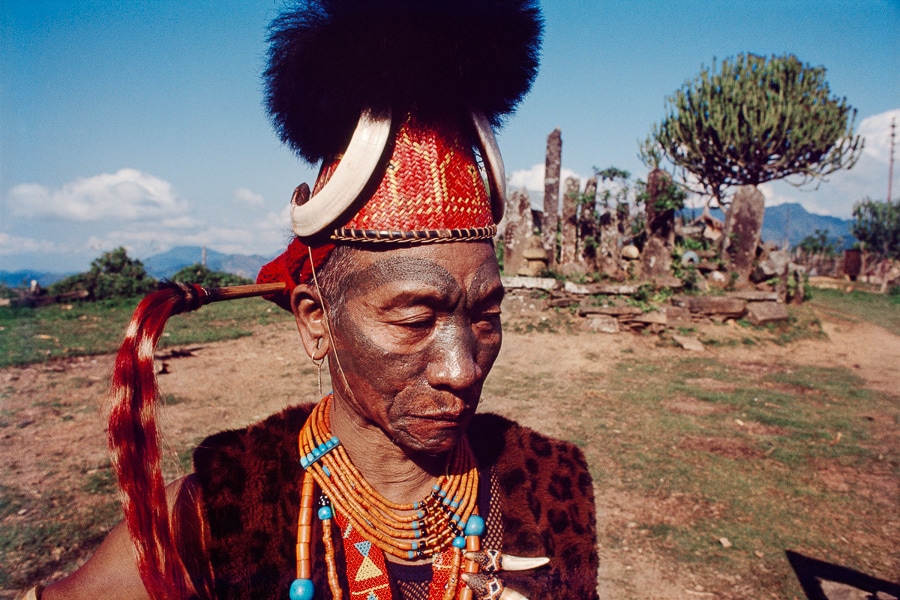 Image: © Pablo Bartholomew
Image: © Pablo Bartholomew
Amongst the Thendu Nagas (Lower Konyaks) was the once-powerful village of Shangnyu. The Ang (Chief) of this village stands in front of a configuration of megalith stones, which symbolise "Fertility". Every time a human head was taken, the village erected a stone to commemorate its trophy. The British banned head hunting in the 1930s. Still, before that, the American Baptist Missionaries who converted many of the Naga tribes to Christianity made not only head hunting taboo but also anything related to their animist beliefs. Still, smatterings of villagers retain their animist beliefs and have to hide the human skulls that their ancestors had taken.
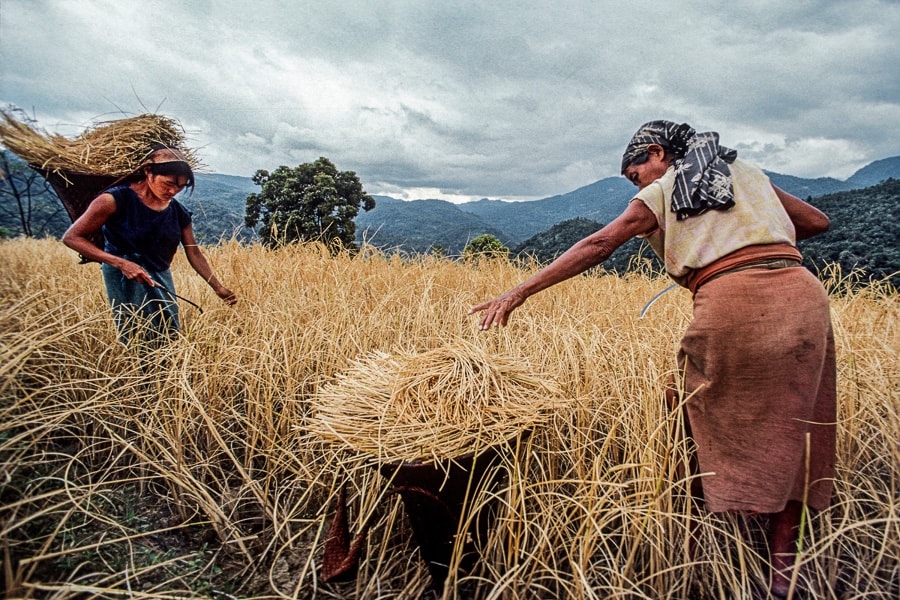 Image: © Pablo Bartholomew
Image: © Pablo Bartholomew
In Western Naga tribes, the Angamis, for example, where there is an abundance of water, terrace cultivation is practised. By late October, the fields are golden brown and ready for harvest. Once the monsoon ends in September, Angami Nagas cut their fields. They gather the cut stems in a large basket, separating the rice from the stalks by hitting them against the side of the basket called Khang. The rice is transported to smaller baskets and carried up to the village, which can be very far away. One can hear songs and shouts all over the hills, which accompany this back-breaking work.
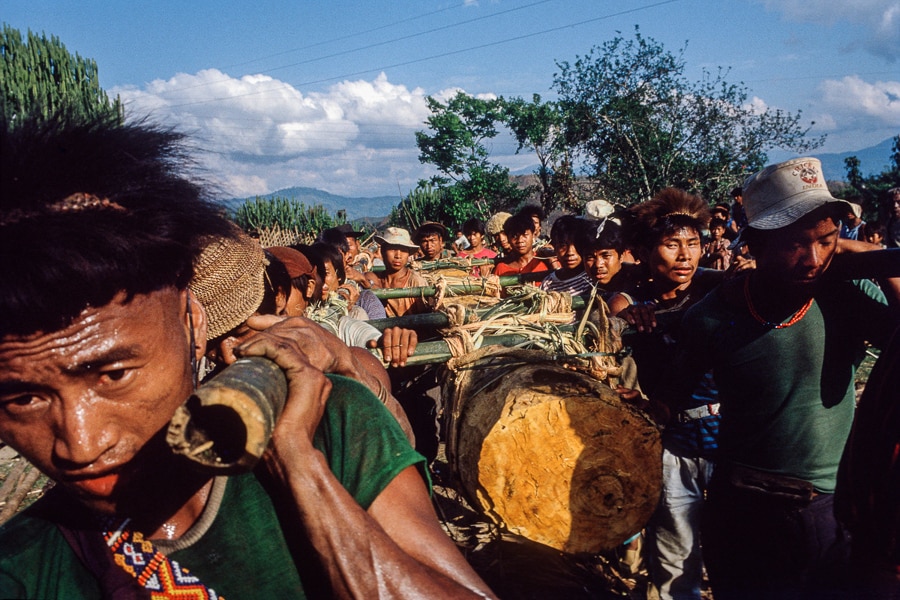 Image: © Pablo Bartholomew
Image: © Pablo Bartholomew
While the reconstruction of the Ang"s (Konyak Naga Chiefs) house is taking place, other groups of men are in the jungle cutting trees and hoisting them on an improvised carrying contraption made with bamboo and vines. Houses are mainly built with poles, bamboo mats, palm leaves and enormous tree trunks.
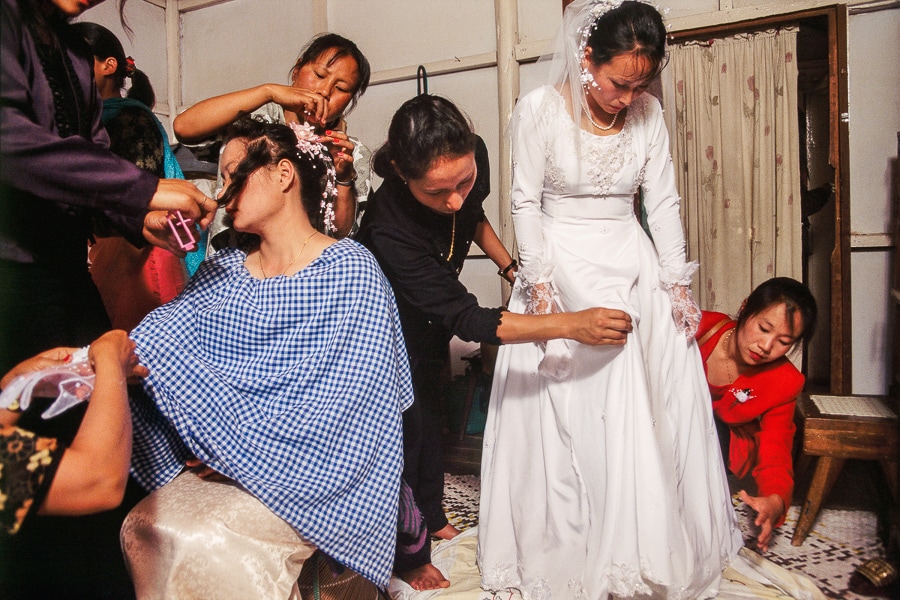 Image: © Pablo Bartholomew
Image: © Pablo Bartholomew
A bride is being dressed in a white bridal dress. Her bridesmaid is in light orange. She will be married according to Baptist rites, and a pastor at KD Baptist Church will perform the wedding.
 Image: © Pablo Bartholomew
Image: © Pablo Bartholomew
Two kids and their aunt enjoy a light moment as they emulate a rock band. The boy uses a tennis racquet as a guitar, and his sister has a pencil in hand as a microphone.
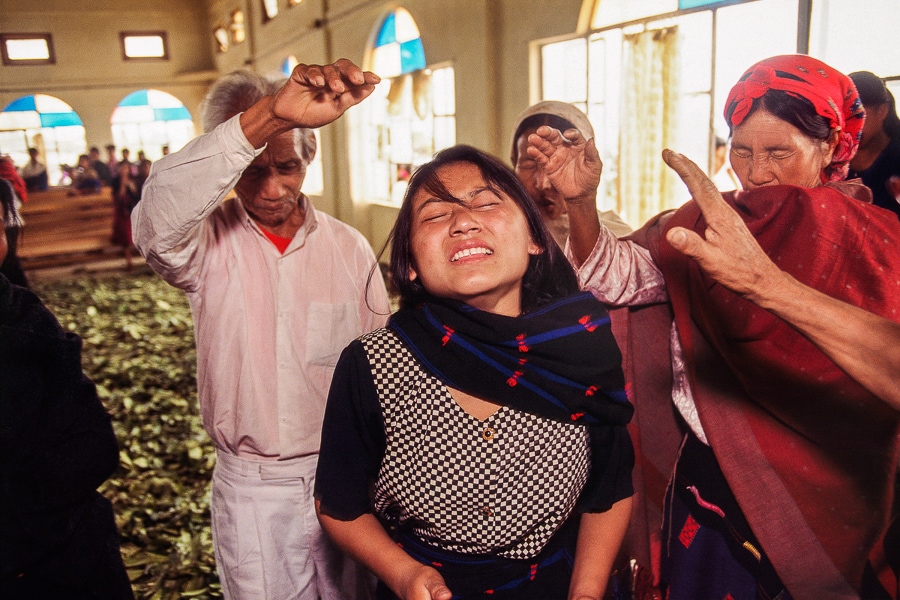 Image: © Pablo Bartholomew
Image: © Pablo Bartholomew
Today, Christianity is an accepted and vital part of Naga ethnicity. In the Gariphema village church, during and after a special revival Baptist service, young girls, women, and men go into ecstatic frenzy and trance, often speaking unheard languages in foreign tongues. They hold these revivals over two or three days to strengthen the villagers" faith. Long sermons and songs mark the occasion.
First Published: Aug 26, 2024, 12:58
Subscribe Now